|
Quick links to other sections on this page . . . The Early Days These Children's Services and their Lantern Shows continued until 1913 by which time the moving image cinematograph was taking off in Bradford and the Eccleshill Picture Palace had opened from late 1911. The church did resume lantern shows in 1922 as part of the service where the lanternists included John William Myers, Willie Tait, John G. Walton and Alan Martin Bakes. The lantern was of the lime burning type. All the equipment including lime and slides (often by Balmforth's of Holmfirth) and their accompanying story script were all supplied by Riley Brothers (Herbert and William) from their lantern slide business in The Colonnade, Westgate and later a small shop in John Street which also sold cine accessories. A narrator read from the script to the story depicted in the slides. Moving Pictures Moving picture shows were also shown at Eccleshill Carnival in a cricket field where the screen was a white sheet suspended between two scaffold poles and with the audience standing or sitting on the grass. Although the films were shown at dusk they were very dim on screen. The films, like the earlier lantern slides, were also supplied by Riley Brothers of John Street who described them as "Cinematograph Entertainments". Their 1903 handbill detailed some of the gems available comprising two separate half-hour performances . . . First Half:The cost to hire was "Fifty Shillings, together with (say) Five Shillings expenses". Since those early pioneering days Eccleshill has been well served by two cinemas although three others, the Idle Picture House in Idle village, the Greengates Cinema on New Line and the Oxford Picture Hall at Undercliffe were all within fairly easy reach.
Eccleshill Picture House 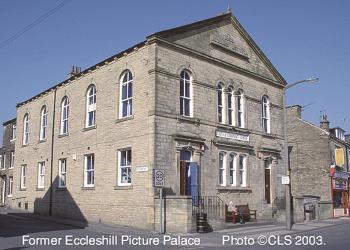
Location and Building The Eccleshill Mechanics Institute was converted by Charles Bottomley into a 359-seater picture hall which he called Eccleshill Picture House. The Opening "A First-Class Programme of Pictures with Piano Accompaniment."The screen was really a white sheet which flapped about in the draught. The blackout was provided by large plywood sheets which had to be put up each evening in the tall semi-circular topped windows. Each blackout board had the message "Please do not whistle, stamp or shout". The seating was upholstered long forms offering a small measure of comfort. Cecil Wray At that time Wray's home was at 27 The Bank, Eccleshill, though in 1912 he moved his business to Leeds and made his home in Chapeltown. He was regarded as one of the film pioneers of the era and a very prominent figure on those early days of the film industry in Bradford through his business connection with other entrepreneurs. Cecil Wray also produced his own Kine-Optiscope - a device which enabled short film strips to be shown using an ordinary magic lantern. Music and Sound Effects Eccleshill Picture House handbill of 1st September 1913 had the following programme . . . "Tiny Tim heals the Breach" - B/W Silent Change of Name 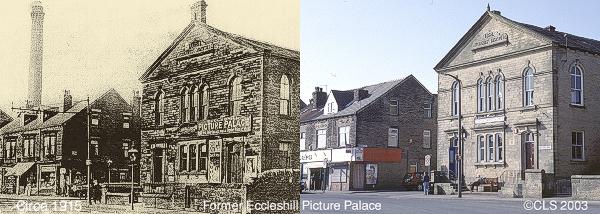 "The Black Mask" - 1913 USA B/W Silent WesternDuring the First World War, a projectionists assistant was Alfred Howarth who at 14 years of age was a 'half-timer' with mornings at school, afternoons in the mill and evenings at the Eccleshill Picture Palace. He was later to buy the Clayton Rialto Picture House and eventually became a director of the Theatre Royal in Bradford. There are stories that the pianist had to be protected by a wire cage from flying apple cores and orange peel from the audience who were prone to show their displeasure at some of the tunes he played. Stereoscopic Screen "The Man who Forgot" - 1919 UK B/WSilentOther films promoted on this screen were . . . "A Lass o' the Looms" - 1919 UK B/W SilentThe film was advertised as Sessue Hayakawa's "great picture" and he appeared in many films spanning over 50 years. Most notably he played Colonel Saito in Bridge on the River Kwai in 1957. Advertisements of the time said " with excellent minor items and orchestral selections" suggesting there was a small orchestra for a short period. The Stereoscopic screen and other experiments with stereoscopy were popular at the time as a means of creating the illusion of pictures in 3-dimensions which for some time had been successfully achieved with still photographs but now with moving pictures. Mechanical Organ Change of Owner A typical 1930 programme advertised . . . "The Wandering Jew" - Local Pianists Other Pianists included Jeanie Cariss, Tom Ditchburn and later a Mr Smith who provided special sound effects such as drums, horns and horse's hooves. Closure and Conversion 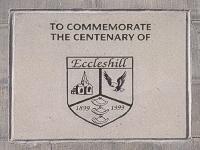
Nowadays the old Mechanics Institute and former cinema is used as the Eccleshill Youth & Community Centre with badminton and dancing on the upper floor and meeting rooms on the lower floor. Its solid Victorian structure is still a prominent landmark of present day "old" Eccleshill.
Palladium / Regal 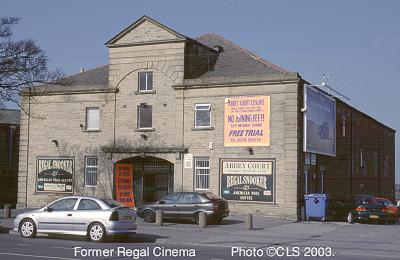
Location The Building The small foyer led directly to two doors to the rear stalls and to the extreme left and right were rather narrow staircases leading up to an equally narrow cross-over corridor with two doors entry to the rear of the circle. The left-hand staircase also had a door leading to another steep staircase to the second floor projection room, rewind and storage rooms. Auditorium The front splay walls accommodated toilets at each side alongside the side exit doors. The proscenium was fitted out with motorised curtains, batten lights and footlights. The arched ceiling with decorative plaster work supported pendant light fittings for main illumination plus wall lights fitted down each side of the stalls. The straight fronted balcony had seven rows of seats in three blocks with two stepped aisles and the back row with double 'love seats'. Although it boasted 1,000 seats, the Council licensing records show 887 seats in 1932 and 861 in 1940 and 17ft 6ins from front row to screen at opening. Confusingly, KYB records show 900 seats in 1950 and 882 in 1962. The Opening "Blood Ship" - 1927 USA B/W Silent 7-reelsThereafter it was continuous performances 6.30 to 10,30pm each weekday evening and three separate performances on Saturdays. For the remainder of that opening week it was . . . "The Temple of Shadows" - 1927 France B/W Silent.A four-piece band accompanied the films and included Stanley Anderson on drums - he was the son of the Chief Surgeon at the Bradford Hospital. The following day the Telegraph & Argus reported . . . "The new picture house, the Palladium at Five Lane Ends, started on its career very successfully last night. Great interest is evidently taken in the new project and a large 'house' assembled. The pictures evidently gave great satisfaction, and the new cinema should prove a great entertainment asset to the district." Talkies Arrive The Palladium screen was installed on a shallow stage with just sufficient room behind for the W.E horn speaker box. The curtains were illuminated by three-coloured footlights with dissolve fading from one colour to another - quite a luxury for a suburban cinema. The first sound film to be shown at the Palladium in May 1930 was . . . "Innocents of Paris" - 1929 USA B/W 69mins. New Owner -New Name The handbills for early 1931 said . . . "Under New ManagementAs the Regal, its seating capacity was reduced to 900 and retained the "double seats" at the back of both the stalls and the Circle balcony; such seats (sometimes nicknamed "love seats") were fast becoming popular with courting couples. During its heyday after the Second World War it was a very popular cinema, a shop unit to the right of the main entrance provided sweets, soft drinks and cigarettes. In the late fifties a rather odd and shortlived "shop" appeared in the upstairs room above the sweetshop accessible only from the Circle staircase. This enterprise selling records and light refreshments as a sort of café but not very well promoted and did not last very long. Other owners of the cinema were Regal Eccleshill Ltd, Sidney Segalman, one of four brothers trading as JOGS Cinemas who were also involved with the Greengates Cinema and later Star Cinemas - a northern 120-cinema chain with its HQ in Castleford and later in Leeds who were controlled by the Eckhart family of Harrogate. Star Refurbishment Externally a new neon sign was erected at the apex of the frontage and the front entrance was completely redesigned with a new paybox and large sales kiosk in the foyer. In the auditorium a new proscenium was constructed in front of the original and level with the front exit doors. The larger proscenium opening of 35 feet allowed a new wide panoramic screen to be installed with adjustable masking for CinemaScope at 33 feet but just with mono sound. The screen had been treated with stripping to give better acoustics. A new set of curtains were fitted and proscenium lighting. Seating capacity was reduced to 882 as seats were removed from the front stalls due to the large screen. The new decorations were very colourful with the auditorium wall panels in Siamese pink and mushroom with burgundy lined relief. The arched ceiling was claret colour with Wedgwood blue mouldings and the ceiling ribs in mushroom. The woodwork was in crimson and the new seats in a dark red. Thick pile carpets down the aisles and in the cross aisles completed the decor. All other areas and facilities were brought up to scratch. Grand Re-opening "The Wind Cannot Read" - 1958 UK Eastmancolor 115mins.The new Regal proudly advertised . . . "To mark the occasion of the Grand Re-opening 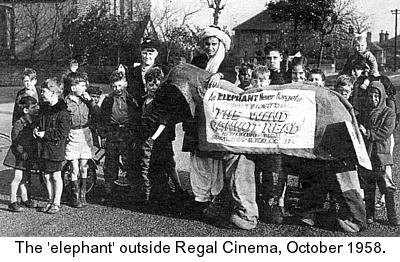 To boost publicity for the re-opening, an "elephant" (based on the pantomime cow idea with two people inside) had been touring the Eccleshill district with a crowd of children following to advertise the opening film "The Wind Cannot Read" which was set in India.
To boost publicity for the re-opening, an "elephant" (based on the pantomime cow idea with two people inside) had been touring the Eccleshill district with a crowd of children following to advertise the opening film "The Wind Cannot Read" which was set in India.For some time afterwards adverts proclaimed . . . "Regal - the new Luxury Cinema of Bradford"and indeed it was - at a cost of over £10,000. Terry Hyde was the new manager for Star. The Eccleshill Star Junior Club matinées started on Saturday 1st November 1958 with comedian Ken Dodd with his 'tickling stick' invited to open the first matinée performance before a crowded house. The Regal was always one of the smarter suburban cinemas of Bradford and never fell into the "local flea pit" category. Closure "Hound of the Baskervilles" - 1959 UK Technicolor 86mins. Projectionist's Memories With the introduction of CinemaScope, the Regal had Wray Optical Works anamorphic lenses of exceptionally high quality. Under Star's ownership these were removed (to another Star cinema) and replaced with lenses of lower quality. The projectionist recalls the office on the first floor being turned into a small café - an unsuccessful venture which did not last very long. Later Uses for Building Following the bingo around 1988, the Regal underwent an internal transformation when the entire proscenium/stage area was removed and the sloping floor of the Stalls was levelled and a low suspended ceiling fitted. This then became the Regal Snooker Club (Snooker Northern Ltd). The upper part of the building including the former Circle remained unused at that time. During this time the building was owned for a period by John Foster who also owned the garage and filling station (now Winders Carpets & Beds) next door. Ownership then changed in the late 1980's to Austin Moran and more recently to his son Simon Moran of SJM Properties in Leeds. In 1998 in a major construction exercise involving the use of a massive crane positioned between the Regal building and Winders Carpet showroom, giant steel girders were inserted through holes in the side wall and anchored on the opposite wall - a rather tricky exercise accomplished with precision. The girders were to support a substantial new floor extending from the front Circle the full length of the building to the internal front wall where once the screen had been. The snooker hall closed for about three weeks during this work. This new entire upper story together with other first floor rooms and the second floor former projection room were to be leased to Abbey Court Leisure for use as a health and fitness centre with structural alterations to accommodate changing rooms and sauna. However the original curved ceiling of the cinema auditorium with its plaster decoration is still visible though the original colours which once highlighted the decoration have been obliterated by the clinical whitewash effect. 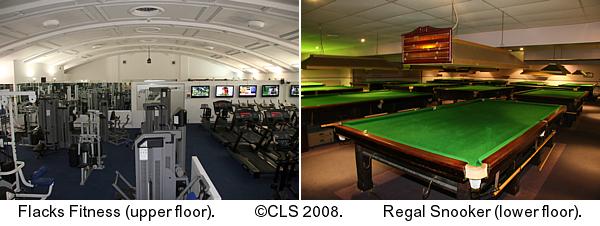 Later the upstairs leisure business was taken over by Martin Flack of MJF Leisure Ltd trading as Flacks Fitness. The whole area was gutted, refurbished and equipped with latest equipment. In 2009 Flacks took over the ground floor following the closure of the snooker hall. Flacks Fitness website acknowledges the previous Regal Cinema origins of the building. May not be copied or reproduced without permission.
|
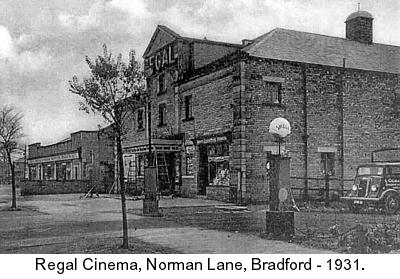 Ralph Dickinson became its first proprietor, but in 1931 the cinema was taken over by John Lambert trading as Modern Theatres and he changed the name to Regal though for several decades afterwards the faded Palladium name could be seen painted on the red brick rear outside wall of the building. John Lambert also had interests in the Rialto Leeds and formed Leeds and Bolton Cinemas Ltd. Lambert added a rectangular canopy over the front entrance seen under construction in the photograph.
Ralph Dickinson became its first proprietor, but in 1931 the cinema was taken over by John Lambert trading as Modern Theatres and he changed the name to Regal though for several decades afterwards the faded Palladium name could be seen painted on the red brick rear outside wall of the building. John Lambert also had interests in the Rialto Leeds and formed Leeds and Bolton Cinemas Ltd. Lambert added a rectangular canopy over the front entrance seen under construction in the photograph.